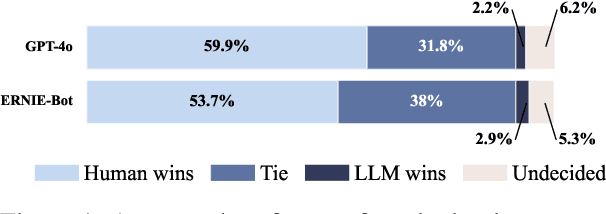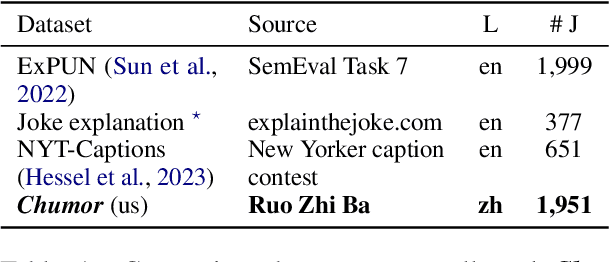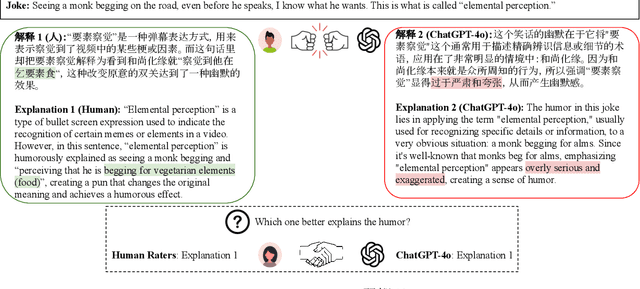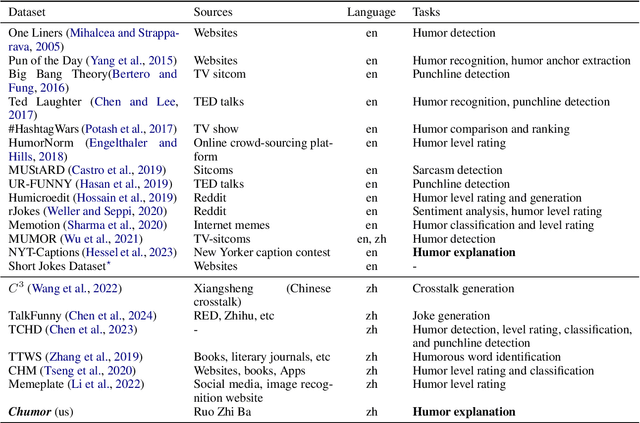Hanchen Xia
Chumor 2.0: Towards Benchmarking Chinese Humor Understanding
Dec 23, 2024



Abstract:Existing humor datasets and evaluations predominantly focus on English, leaving limited resources for culturally nuanced humor in non-English languages like Chinese. To address this gap, we construct Chumor, the first Chinese humor explanation dataset that exceeds the size of existing humor datasets. Chumor is sourced from Ruo Zhi Ba, a Chinese Reddit-like platform known for sharing intellectually challenging and culturally specific jokes. We test ten LLMs through direct and chain-of-thought prompting, revealing that Chumor poses significant challenges to existing LLMs, with their accuracy slightly above random and far below human. In addition, our analysis highlights that human-annotated humor explanations are significantly better than those generated by GPT-4o and ERNIE-4-turbo. We release Chumor at https://huggingface.co/datasets/dnaihao/Chumor, our project page is at https://dnaihao.github.io/Chumor-dataset/, our leaderboard is at https://huggingface.co/spaces/dnaihao/Chumor, and our codebase is at https://github.com/dnaihao/Chumor-dataset.
Chumor 1.0: A Truly Funny and Challenging Chinese Humor Understanding Dataset from Ruo Zhi Ba
Jun 18, 2024



Abstract:Existing humor datasets and evaluations predominantly focus on English, lacking resources for culturally nuanced humor in non-English languages like Chinese. To address this gap, we construct Chumor, a dataset sourced from Ruo Zhi Ba (RZB), a Chinese Reddit-like platform dedicated to sharing intellectually challenging and culturally specific jokes. We annotate explanations for each joke and evaluate human explanations against two state-of-the-art LLMs, GPT-4o and ERNIE Bot, through A/B testing by native Chinese speakers. Our evaluation shows that Chumor is challenging even for SOTA LLMs, and the human explanations for Chumor jokes are significantly better than explanations generated by the LLMs.
SQL-CRAFT: Text-to-SQL through Interactive Refinement and Enhanced Reasoning
Feb 20, 2024Abstract:Modern LLMs have become increasingly powerful, but they are still facing challenges in specialized tasks such as Text-to-SQL. We propose SQL-CRAFT, a framework to advance LLMs' SQL generation Capabilities through inteRActive reFinemenT and enhanced reasoning. We leverage an Interactive Correction Loop (IC-Loop) for LLMs to interact with databases automatically, as well as Python-enhanced reasoning. We conduct experiments on two Text-to-SQL datasets, Spider and Bird, with performance improvements of up to 5.7% compared to the naive prompting method. Moreover, our method surpasses the current state-of-the-art on the Spider Leaderboard, demonstrating the effectiveness of our framework.
EVNet: An Explainable Deep Network for Dimension Reduction
Nov 21, 2022Abstract:Dimension reduction (DR) is commonly utilized to capture the intrinsic structure and transform high-dimensional data into low-dimensional space while retaining meaningful properties of the original data. It is used in various applications, such as image recognition, single-cell sequencing analysis, and biomarker discovery. However, contemporary parametric-free and parametric DR techniques suffer from several significant shortcomings, such as the inability to preserve global and local features and the pool generalization performance. On the other hand, regarding explainability, it is crucial to comprehend the embedding process, especially the contribution of each part to the embedding process, while understanding how each feature affects the embedding results that identify critical components and help diagnose the embedding process. To address these problems, we have developed a deep neural network method called EVNet, which provides not only excellent performance in structural maintainability but also explainability to the DR therein. EVNet starts with data augmentation and a manifold-based loss function to improve embedding performance. The explanation is based on saliency maps and aims to examine the trained EVNet parameters and contributions of components during the embedding process. The proposed techniques are integrated with a visual interface to help the user to adjust EVNet to achieve better DR performance and explainability. The interactive visual interface makes it easier to illustrate the data features, compare different DR techniques, and investigate DR. An in-depth experimental comparison shows that EVNet consistently outperforms the state-of-the-art methods in both performance measures and explainability.
 Add to Chrome
Add to Chrome Add to Firefox
Add to Firefox Add to Edge
Add to Edge